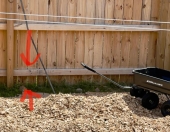
 1
1




 2
2




John Daley Bendigo, Australia The Enemy of progress is the hope of a perfect plan
Benefits of rainfall collection https://permies.com/t/88043/benefits-rainfall-collection
GOOD DEBT/ BAD DEBT https://permies.com/t/179218/mortgages-good-debt-bad-debt
 1
1




John C Daley wrote:Dusty, I suggest you get modern materials for such an important part of the building.
Use either concrete or steel posts.
Timber and even treated timber can fail in particular cases, buy using say, concrete stumps you can be up and
going within hours, not days or weeks with the system you have spoken about.
 1
1




John Daley Bendigo, Australia The Enemy of progress is the hope of a perfect plan
Benefits of rainfall collection https://permies.com/t/88043/benefits-rainfall-collection
GOOD DEBT/ BAD DEBT https://permies.com/t/179218/mortgages-good-debt-bad-debt

 4
4








Country oriented nerd with primary interests in alternate energy in particular solar. Dabble in gardening, trees, cob, soil building and a host of others.
 1
1




John Daley Bendigo, Australia The Enemy of progress is the hope of a perfect plan
Benefits of rainfall collection https://permies.com/t/88043/benefits-rainfall-collection
GOOD DEBT/ BAD DEBT https://permies.com/t/179218/mortgages-good-debt-bad-debt
 1
1




C. Letellier wrote:Do you live some place you can get black locust lumber? Borate spray it for termite protection and a tiny bit of fire protection and its natural rot resistance should do the rest.

 2
2




L. Johnson wrote:Had I the resources and time in your situation this is what I would do. You may have a different take, but since you're asking for ideas...
I would try to find some field stone large enough to support the deck (or pergola) as a foundation. I would spend a lot of time choosing the best rocks and then try to pull a Mr. Chickadee:
As far as the wood itself goes, I would try to find the best naturally rot/bug resistant wood available to me. Maybe that is cedar. Maybe it is cypress. Maybe it's just cherry (wow a cherry deck).
I would probably char it, or maybe just the underside. I don't know what happens when you char things other than cedar though.
If at all possible I would build a roof so that rain and sun exposure is limited.
Lastly I would expect to do yearly maintenance on the deck/pergola.
For the last reason especially I wouldn't build a large deck. I'd keep it as small as possible while still allowing me to do what I want on it.
 2
2




John C Daley wrote:Fair point, but if you compare treating you own wood, with purchasing concrete or treated timber stumps
you may find the purchase a good use of debt and time.
By using your own timber on top of the stumps you could have the deck set out in a week perhpas.
What do you think?
 1
1




but the satisfaction of doing it myself carries some weight
John Daley Bendigo, Australia The Enemy of progress is the hope of a perfect plan
Benefits of rainfall collection https://permies.com/t/88043/benefits-rainfall-collection
GOOD DEBT/ BAD DEBT https://permies.com/t/179218/mortgages-good-debt-bad-debt
 2
2




Invasive plants are Earth's way of insisting we notice her medicines. Stephen Herrod Buhner
Everyone learns what works by learning what doesn't work. Stephen Herrod Buhner
 3
3




Anne Miller wrote:The OP said he has cedar growing on his property.
Would using cedar rather than treating wood be better?




John Daley Bendigo, Australia The Enemy of progress is the hope of a perfect plan
Benefits of rainfall collection https://permies.com/t/88043/benefits-rainfall-collection
GOOD DEBT/ BAD DEBT https://permies.com/t/179218/mortgages-good-debt-bad-debt




 2
2




John Daley Bendigo, Australia The Enemy of progress is the hope of a perfect plan
Benefits of rainfall collection https://permies.com/t/88043/benefits-rainfall-collection
GOOD DEBT/ BAD DEBT https://permies.com/t/179218/mortgages-good-debt-bad-debt
 6
6




Cody Reece wrote:I know this post is a few years old but I’m curious how it turned out for you. I’m looking to do something very similar. I’ve got some pines I’ll be removing and a deck that needs redone. Also wouldn’t mind having extra treated lumber for any other projects.
"Ah, but a man's reach should exceed his grasp,
Or what's a heaven for?"
Andrea del Sarto by Robert Browning
 3
3




John C Daley wrote:Can I ask why the deck needs redoing? Has it degraded over time, wood rotten?
 4
4




 3
3




Kevin Olson wrote:
Cody Reece wrote:I know this post is a few years old but I’m curious how it turned out for you. I’m looking to do something very similar. I’ve got some pines I’ll be removing and a deck that needs redone. Also wouldn’t mind having extra treated lumber for any other projects.
No worries on responding to an old post, Cody, and welcome to Permies!
Again, welcome to Permies!

|
Lookout! Runaway whale! Hide behind this tiny ad:
The new gardening playing cards kickstarter is now live!
https://www.kickstarter.com/projects/paulwheaton/garden-cards
|


